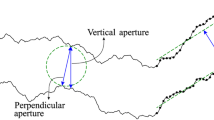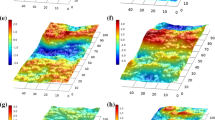Abstract
Macroscopic nonlinear flow, which is closely related to mesoscopic flow structures such as vortices, is an important property of fluid flow and solute transport in rock fractures with a high pressure gradient. Both mesoscopic flow structure and macroscopic nonlinear flow of rock fractures are affected by fracture roughness and aperture. Therefore, the macroscopic seepage process in fractures is studied numerically by directly solving the Navier–Stokes equation. The results demonstrate that the Forchheimer equation can be used to describe the relationship between flow rate and pressure gradient of rough fractures with different apertures. The linear and nonlinear coefficients of the Forchheimer equation increase with fracture roughness and decrease with fracture aperture. Empirical formulas between the linear coefficient, the nonlinear coefficient, the fracture roughness and aperture are established. When the roughness is equal to zero, the empirical formulas can degenerate into conventional cubic law. In additions, the distribution characteristics of the mesoscopic flow structure in rough fractures are also investigated. The results show that the area and kinetic energy distribution characteristics of the mesoscopic flow structure in fractures with different roughness and apertures are similar. The frequency characteristics of the area and kinetic energy of the mesoscopic flow structure in fractures can be fitted with negative exponential and logarithmic normal functions, respectively. The effect of fracture roughness on area and kinetic energy distribution characteristics is significant, but the effect of aperture can be ignored. Empirical formulas between fracture roughness and mesoscopic flow structure characteristics are established for the first time.

















Similar content being viewed by others
References
Briggs S, Karney BW, Sleep BE (2017) Numerical modeling of the effects of roughness on flow and eddy formation in fractures. J Rock Mech Geotech 9(1):105–115
Brush DJ, Thomson NR (2003) Fluid flow in synthetic rough-walled fractures: Navier-Stokes, Stokes, and local cubic law simulations. Water Resour Res 39(4):1085
Canbolat S, Parlaktuna M (2019) Analytical and visual assessment of fluid flow in fractured medium. J Petrol Sci Eng 173:77–94
Chaudhary K, Cardenas MB, Deng W, Bennett PC (2011) The role of eddies inside pores in the transition from Darcy to Forchheimer flows. Geophys Res Lett 38:L24405
Chen YF, Liu MM, Hu SH, Zhou CB (2015) Non-Darcy’s law-based analytical models for data interpretation of high-pressure packer tests in fractured rocks. Eng Geol 199:91–106
Chen Z, Qian J, Zhan H, Zhou Z, Wang J, Tan Y (2017) Effect of roughness on water flow through a synthetic single rough fracture. Environ Earth Sci 76:186–202
Deng H, Molins S, Trebotich D, Steefel C, DePaolo D (2018) Pore-scale numerical investigation of the impacts of surface roughness: upscaling of reaction rates in rough fractures. Geochim Cosmochim Acta 239:374–389
Dong J, Ju Y (2020) Quantitative characterization of single-phase flow through rough-walled fractures with variable apertures. Geomech Geophys Geo-Energy Geo-Resour 6(3):42
Dou Z, Chen Z, Zhou Z, Wang J, Huang Y (2018) Influence of eddies on conservative solute transport through a 2D single self-affine fracture. Int J Heat Mass Transf 121:597–606
Folch A, Menció A, Puig R, Soler A, Mas-Pla J (2011) Groundwater development effects on different scale hydrogeological systems using head, hydrochemical and isotopic data and implications for water resources management: the Selva basin (NE Spain). J Hydrol 403:83–102
Forchheimer PH (1901) Wasserbewegung durch boden. Zeit Ver Deutsch Ing 45:1782–1788
Giacomini A, Buzzi O, Ferrero AM, Migliazza M, Giani GP (2008) Numerical study of flow anisotropy within a single natural rock joint. Int J Rock Mech Min Sci 45(1):47–58
Hajjar A, Scholtès L, Oltéan C, Buès MA (2018) Effects of the geometry of two-dimensional fractures on their hydraulic aperture and on the validity of the local cubic law. Hydrol Process 32:2510–2525
Huang Y, Zhang Y, Yu Z, Ma Y, Zhang C (2019) Experimental investigation of seepage and heat transfer in rough fractures for enhanced geothermal systems. Renew Energy 135:846–855
Jiang Q, Ye Z, Zhou C (2014) A numerical procedure for transient free surface seepage through fracture networks. J Hydrol 519:881–891
Konzuk JS, Kueper BH (2004) Evaluation of cubic law based models describing single-phase flow through a rough-walled fracture. Water Resour Res 40(2):W02402
Lee SH, Lee KK, Yeo IW (2014) Assessment of the validity of Stokes and Reynolds equations for fluid flow through a rough-walled fracture with flow imaging. Geophys Res Lett 41(13):4578–4585
Liu J, Wang Z, Qiao L, Li W, Yang J (2021) Transition from linear to nonlinear flow in single rough fractures: effect of fracture roughness. Hydrogeol J 29:1343–1353
Luo J, Zhu Y, Guo Q, Tan L, Zhuang Y, Liu M, Zhang C, Xiang W, Rohn J (2017) Experimental investigation of the hydraulic and heattransfer properties of artificially fractured granite. Sci Rep 7(1):39882
Luo Y, Zhang ZY, Zhang L, Xue KS, Long K (2022) Influence of fracture roughness and void space morphology on nonlinear fluid flow through rock fractures. Eur Phys J plus 137:1288
Ni XD, Niu YL, Wang Y, Yu K (2018) Non-Darcy flow experiments of water seepage through rough-walled rock fractures. Geofluids. https://doi.org/10.1155/2018/8541421
Nicholl MJ, Rajaram H, Glass RJ, Detwiler R (1999) Saturated flow in a single fracture: evaluation of the Reynolds equation in measured aperture fields. Water Resour Res 35(11):3361–3373
Nicholl MJ, Detwiler RL (2011) Simulation of flow and transport in a single fracture: macroscopic effects of underestimating local head loss. Geophys Res Lett 28(23):4355–4358
Phillips T, Bultreys T, Bisdom K, Kampman N, Van Offenwert S, Mascini A, Cnudde V, Busch A (2020) A systematic investigation into the control of roughness on the flow properties of 3d-printed fractures. Water Resour Res. https://doi.org/10.1029/2020WR028671
Renshaw CE (1995) On the relationship between mechanical and hydraulic apertures in rough-walled fractures. J Geophys Res 100(B12):24629–24636
Singh H, Cai J (2018) Screening improved recovery methods in tight-oil formations by injecting and producing through fractures. Int J Heat Mass Transf 116:977–993
Snow D (1968) Rock fracture spacing, apertures and porosities. J Soil Mech Found Div Proc ASCE 94(SMI):73–91
Tse R, Cruden DM (1979) Estimating joint roughness coefficients. Int J Rock Mech Min Sci Geomech Abstr 16(5):303–307
Wang L, Cardenas MB, Slottke DT, Ketcham RA, Sharp JM (2015) Modification of the local cubic law of fracture flow for weak inertia, tortuosity, and roughness. Water Resour Res 51:2064–2080
Wang Y, Su B (2002) Research on the behavior of fluid flow in a single fracture and its equivalent hydraulic aperture. Adv Water Sci 13(1):61–68
Wang ZC, Li W, Li Z, Liu XL, Liang JY, Zhong SR (2020) Groundwater response to oil storage in large-scale rock caverns with a water curtain system: site monitoring and statistical analysis. Tunn Undergr Space Technol 99:103363
Xing K, Qian J, Ma H, Luo Q, Ma L (2021) Characterizing the relationship between non-darcy effect and hydraulic aperture in rough single fractures. Water Resour Res. https://doi.org/10.1029/2021WR030451
Zhang Q, Luo SH, Ma HC, Wang X, Qian JZ (2019) Simulation on the water flow affected by the shape and density of roughness elements in a single rough fracture. J Hydrol 573:456–468
Zhang Y, Chai J, Cao C, Shang T (2021) Combined influences of shear displacement, roughness, and pressure gradient on nonlinear flow in self-affine fractures. J Petrol Sci Eng 198:108229
Zimmerman RW, Bodvarsson GS (1996) Hydraulic conductivity of rock fractures. Trans Porous Media 23:1–30
Zimmerman RW, Al-Yaarubi A, Pain CC, Grattoni CA (2004) Non-linear regimes of fluid flow in rock fractures. Int J Rock Mech Min Sci 41:163–169
Zhou JQ, Wang LC, Chen YF, Cardenas MB (2019) Mass transfer between recirculation and main flow zones: is physically based parameterization possible? Water Resour Res 55(1):345–362
Zhu Q, Yin Q, Huang N, Wu J, Zhang Q, Li T, Yu L (2022) Assessment of nonlinear flow behaviors through real rough rock fractures during shearing. Geomech Geophys Geo-Energy Geo-Resour 8:171
Zou LC, Jing LR, Vladimir C (2017) Shear-enhanced nonlinear flow in rough-walled rock fractures. Int J Rock Mech Min Sci 97:33–45
Acknowledgements
This study was financially supported by the National Natural Science Foundation of China under Contract Nos. 51779045 and 42177157, the Fundamental Research Funds for the Central Universities under Contract No. N2001026, Liao Ning Revitalization Talents Program under Contract No. XLYC1807029 and Liaoning Natural Science Foundation under Contract No. 2019-YQ-02.
Author information
Authors and Affiliations
Contributions
All authors contributed to the study conception and design. Material preparation and analysis were performed by JY and ZW. The first draft of the manuscript was written by JY and all authors commented on previous versions of the manuscript. All authors read and approved the final manuscript.
Corresponding author
Ethics declarations
Conflict of interest
On behalf of all authors, the corresponding author states that there is no conflict of interest.
Additional information
Publisher's Note
Springer Nature remains neutral with regard to jurisdictional claims in published maps and institutional affiliations.
Rights and permissions
Springer Nature or its licensor (e.g. a society or other partner) holds exclusive rights to this article under a publishing agreement with the author(s) or other rightsholder(s); author self-archiving of the accepted manuscript version of this article is solely governed by the terms of such publishing agreement and applicable law.
About this article
Cite this article
Yang, J., Wang, Z., Qiao, L. et al. Effects of roughness and aperture on mesoscopic and macroscopic flow characteristics in rock fractures. Environ Earth Sci 82, 594 (2023). https://doi.org/10.1007/s12665-023-11290-7
Received:
Accepted:
Published:
DOI: https://doi.org/10.1007/s12665-023-11290-7




